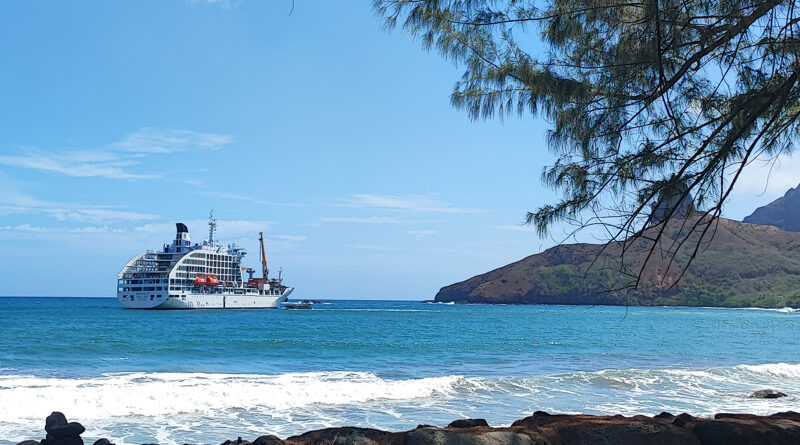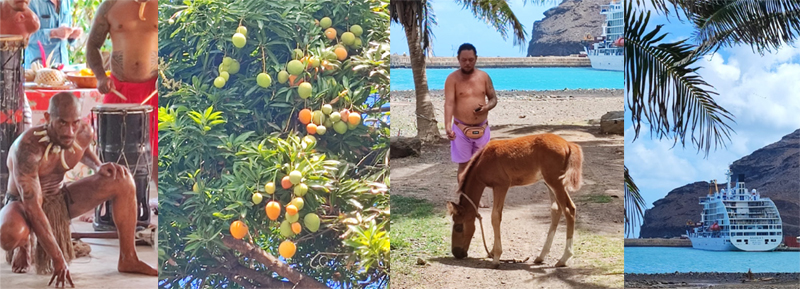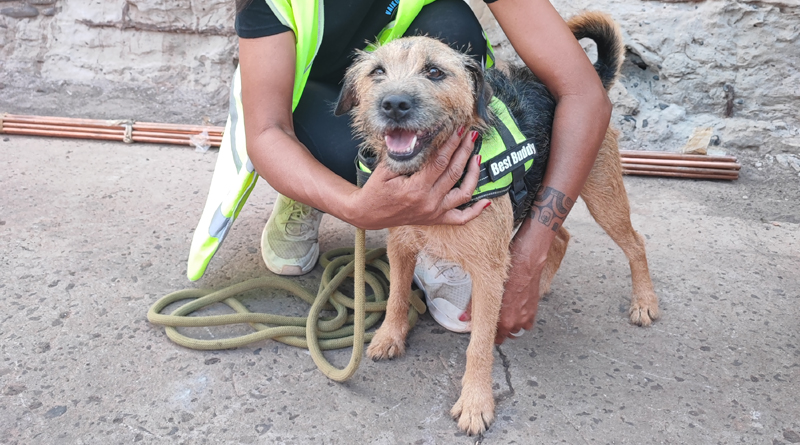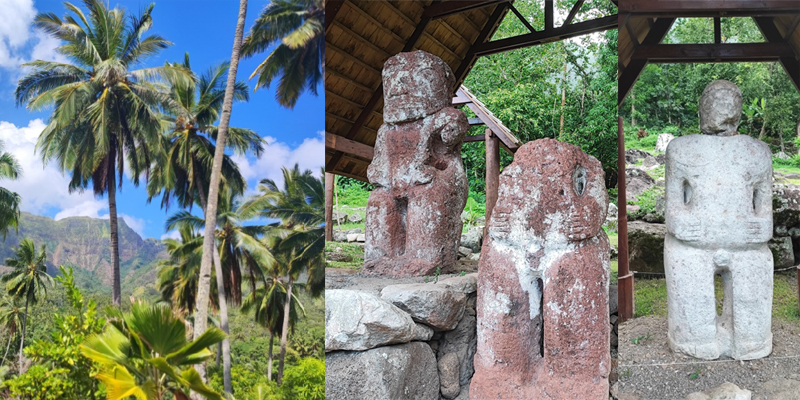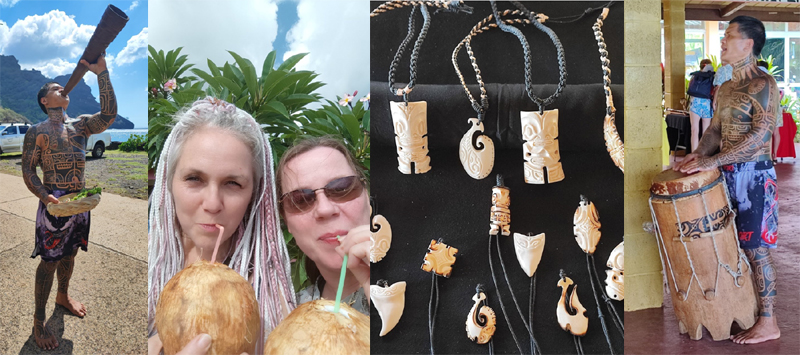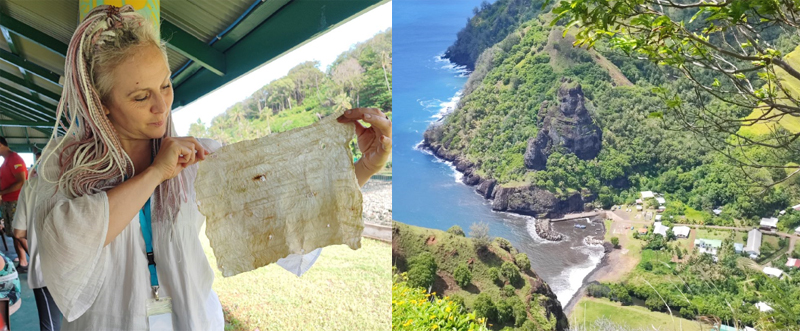ARANUI 5 BRINGS MORE THAN TOURISTS TO THE MARQUESAS ISLANDS
‘A once in a lifetime trip’- that’s how most of the passengers I spoke to on the Aranui 5 described their trip to the remote Marquesas Islands in French Polynesia.
You can fly direct to Los Angeles or San Francisco (and perhaps build in a few days stop-over) and then you take an eight-hour flight to Tahiti. At Tahiti you board the Aranui 5, a part-passenger-part-freight ship, and start the sea voyage to the Marquesas. The cruise is a 12-day round trip, and you’ll see plenty that will make you want to visit again.
Once you arrive at the Marquesas it is like stepping into paradise – bright blue skies, permanent warmth, foam topped waves breaking against the shore, and trees laden with tropical fruits. The people are welcoming and everywhere you go you’ll be treated to music, dancing and a display of traditional handicrafts and locally farmed pearls.
THE ISLANDS
Each island is distinctive in its own right:
Nuku Hiva
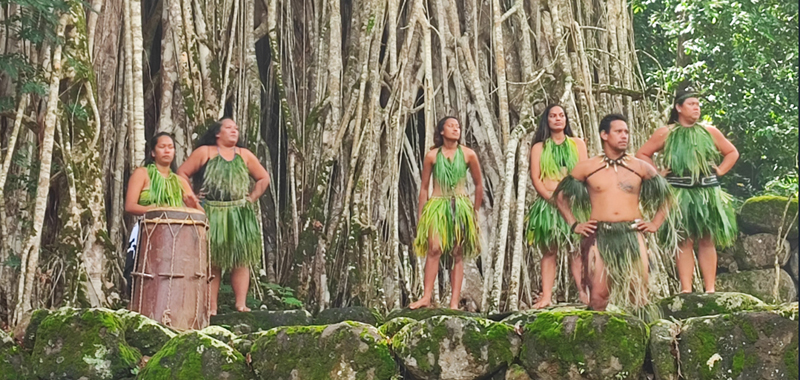
Nuku Hiva, usually the first island stop, is lush and green with cloud topped peaks and rocky coves. With its cathedral and Christian history, it is an interesting place to learn about how the islands have changed thanks to the influx of Westerners. The previous Catholic Bishop, in the name of his Lord, banned all forms of ‘pagan’ worship, the carving of Tikis (stone carvings that represent the gods and deified ancestors), tattoos, traditional music and dancing, and the native language. Unfortunately, he lived to a ripe old age meaning many young people grew up with no links to their past, their language or their traditional arts. Fortunately, his successor was more open minded and over the last 40 years or so there has been a concerted effort to undo the damage and rediscover the traditional arts, dances, music and language.
Visit an ancient archaeological site, watch dancers perform under the boughs of the largest and oldest Banyan tree in French Polynesia, relax on the sandy beaches or hire an outrigger for a couple of hours on the water.
Ua Pou
Towering volcanic peaks peer over pale sandy beaches with rocky coves and palm trees. Horses graze among the trees and fruit hangs low on the trees. But what this island is really
known for is its Flower Stone, which, as the name suggests, is local stone naturally patterned over the eons with ‘flower’ shapes. This stone is craved into beautiful handicrafts, from statues to jewellery.
Ua Huka
On arid Ua Huka the highlights are turtles, rays, over 1500 horses and the rare endemic Ultramarine Lorikeet. Due to the importance of its rare birds, Ua Huka is also home to Tip, a specially trained rat catcher dog. Tip stands on the quayside with her handler Sabrina and checks that no black rats make it onto the island as the cargo and passengers come ashore. Black rats can wreak havoc on breeding birds eating both the eggs and young chicks. Tip, and her retired predecessor, have kept the island, and its grateful birds, safe.
Hiva Oa
For art and music lovers Hiva Oa will stand out. This island is the resting place of Paul Gauguin and French singer/actor Jacques Brel (and his aeroplane, JoJo). A short uphill hike will take you to the cemetery and back in the centre of Atuona village you can visit the two museums dedicated to these men.
But Western art isn’t all it has to offer. Most people have heard of Easter Island and its giant Tikis, but did you know Hiva Oa is home to the biggest Tikis in the Marquesas? A 4×4 will take you to the site where you can see these stone carvings up close and learn what they (probably) meant for the ancient peoples who made them.
Tahuata
Many of the men of the Marquesas wear pig bones or tusks around their necks – some intricately carved and if you’d like a bone carving (not something I am keen on, to be honest) then Tahuata is the place to buy it. It’s also a good place to drink from a fresh coconut and admire the traditional black tattoos snaking over the bare chests and arms of the local men. Each tattoo will have a specific meaning for its wearer, and they are usually very happy to tell you more about them.
Fatu Hiva
Ever fancied hiking a volcano? Then Fatu Hiva is the place. A solid five miles up to the top and then another five downhill – with ‘well worth it’ views all the way. And a delicious lunch at the peak. If hiking isn’t your thing, then spend your time learning how to make the traditional Tapa – a type of ‘paper’ made from tree bark and inked with beautiful designs.
ARANUI 5
Although it is possible to fly to some of the islands, cruising is the best way to see them. And by boarding Aranui 5 you’ll also be helping to support an important supply line to the islands as the ship carries freight as well as passengers. On our cruise we were carrying everything from helicopter parts to a horse, from fizzy drinks to ‘store cupboard staples’, plus building materials, car spares, and machinery. Almost anything the islanders want must be imported, and much of it arrives on Aranui 5. At each island the locals gather round to watch the pallets unloaded on to the dock and then rush forward to claim what is theirs and sign the relevant paperwork.
Traveling by ship also allows you to move between the islands while eating or sleeping – so no wasted time! But for me, handy as that is, that’s not the best part of cruising. The best part is the people; I have always met a range of lovely and interesting people when cruising. The ‘shared experience’ camaraderie, the meals together, and the evening cocktails all help to encourage friendships and sometimes, lifelong bonds.
Sustainability
But how sustainable is this form of travel? The cruise industry hasn’t always had the best of reputations when it comes to care for the environment. So, how does the Aranui 5 stack up?
The fact that it carries both freight and passengers on a route where delivery of the freight is an essential lifeline, already makes for an excellent start.
Aranui 5 has a dedicated team member who oversees the processing of waste on the ship, with facilities that are more advanced than those available on the islands. All the rubbish is sorted on board: glass, plastic bottles, aluminium cans, food waste, paper, batteries, electronic waste, even the ash and exhaust dust.
This is then prepared while still on board. For example, the plastic is compacted, the caps on glass bottles are removed to aid recycling, and paper and cartons are incinerated producing ash. All of this is landed back in Tahiti, where a specialist company, TSP, deals with recycling, reprocessing and disposal.
In line with international marine legislation, food waste (with all non-food items removed) is discharged at sea at least 12 nautical miles from the coast.
Complying to the international marine regulation to reduce atmospheric pollution, Aranui 5 burns only Marine Diesel Oil of less than 0.5% sulphur content. In addition, while at sea, the onboard energy is exclusively produced by the propulsion engines’ shaft generators thus limiting the need to run diesel generators to ‘in port’ operations.
All lighting on board is low energy and even the deck floodlights are LED, consuming almost 10 times less than a conventional halogen lamp.
Hopefully you brought your own reusable water bottle with you, but just in case you forgot, Aranui 5 can supply you with a reusable water bottle which can be filled up at the drinking water stations on almost every deck.
All waste water passes through a miniature waste water treatment plant with filtration, bubbling and settling systems. This means only clear water is ultimately discharged into the sea. These discharges are carried out in compliance with international regulations (MARPOL Annex 4) which state you must be at least three nautical miles from the coast. Aranui 5 has opted to go further than this and only ejects cleaned waste water beyond four miles from the coast.
No water is shipped to the Marquesas. Aranui 5 fills up with water in Papeete and then produces the remainder it needs throughout the trip. This water is seawater that has been through desalination by reverse osmosis. Each of these two “osmoses” is capable of producing twice the ship’s daily needs.
To comply with the 2004 International Convention for the Treatment of Ballast Water, Aranui 5 has a ballast water treatment facility. Ballast water is seawater that is brought onboard to artificially ballast the ship when it is empty (providing better stability). The ballast treatment system means that all the water is filtered and micro-organisms are killed which ensures that unloading it in other geographical areas doesn’t introduce invasive species.
Contrary to popular belief, bilge water in the ship is not thrown into the sea without treatment. Rather, it is processed to ensure that the oil and water are separated, with the water containing no more than seven parts per million of hydrocarbons. The maximum content set by the MARPOL international regulation annex 1, is 15ppm; the Aranui 5 has managed to halve this. The separated hydrocarbon residues are incinerated.
In 2022, “Compagnie Polynésienne de Transport Maritime” (owners of Aranui 5) volunteered to join the GREEN MARINE program, the leading environmental certification program for North America and Europe. Like a few other shipowners worldwide, the company is now certified GREEN MARINE in recognition of its commitment to improve its environmental performance beyond the level set by regulation. This is assessed annually and verified externally.
All travel creates the risk of introducing invasive species and Aranui 5 routinely places rat guards on her moorings to prevent them from boarding/disembarking, and the ship’s Environmental Officer places traps against cockroaches and small fire ants, as well as performing regular preventive treatments in the holds and accommodations of the ship.
So, is Aranui 5 a sustainable way to see the Marquesas? The truth is, any form of travel will have an environmental impact and will produce CO2 emissions, but in terms of visiting the islands this is far more sustainable than flying or hiring your own boat.
The main impact is the flights required to get you to Tahiti in the first instance. It is always a delicate balance; tourism is essential for the survival of the people on the islands and yet being a tourist has a negative impact on the environment. But choosing transport options that have carefully mitigated their impact as much as possible and provide other benefits too goes a long way to creating a healthy balance. For the flights, look for airlines genuinely doing something to reduce their impact today and eliminate it in entirely in the future, and offset (not an ideal solution, but better than nothing) the CO2 emissions your flight produces.
FACT BOX:
The 12-day Discover the Marquesas Cruise on board Aranui 5 costs from Euros 4,623 pp. Price includes accommodation in a Double Stateroom with obstructed view, (based on two sharing), all meals (incl. wine with meals), taxes and scheduled excursions. Excludes international flights. To book visit aranui.com
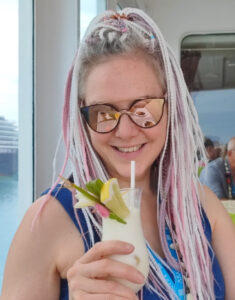 ABOUT THE AUTHOR
ABOUT THE AUTHOR
Chantal Cooke is an award-winning journalist and broadcaster and co-founder of PASSION for the PLANET.
Chantal is passionate about tourism being used as a force for good. You can follow her adventures on Facebook and Twitter @chantalcooke and on Instagram @Chantaldcooke

